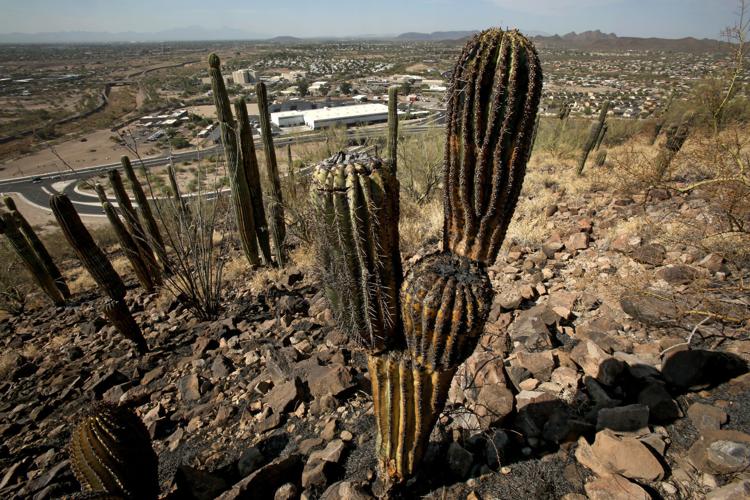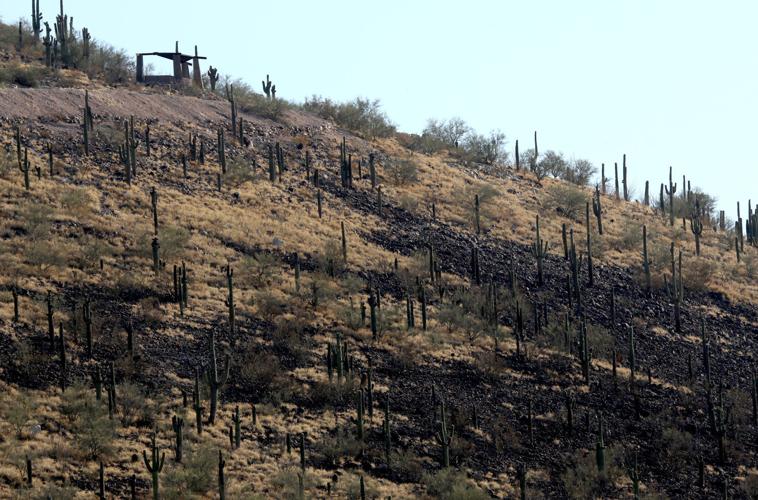There are those who say itтs not a real УлшжжБВЅ Fourth of July fireworks show without a brush fire on Sentinel Peak.
If thatтs true, this yearтs show certainly did not disappoint.
Not too long after the fireworks started around 9:15 p.m., the colorful blasts set the grass-covered south slope of the prominent peak ablaze, and УлшжжБВЅ Fire Department personnel т staged nearby for rapid response т had it largely extinguished by 11:15 p.m. The exact fire size isnтt known, but Assistant Chief Joe Gulotta said it was possibly around an acre, and crews were able to keep it to that size thanks to preparations made before the show.
That pales in comparison to the ongoing Burro Fire, which has consumed over 26,000 acres in the Santa Catalina Mountains.
Nevertheless, some local researchers and advocates say the тAт Mountain fire was a high-profile public demonstration of the threat posed by buffelgrass, the invasive species that covers much of Sentinel Peakтs southern flank. Several expressed hope the incident will spur additional eradication efforts there and elsewhere, something Gulotta said he supports.
People are also reading…
He also said his department will review its incident management plan for next yearтs event with special consideration of the invasive grass.
тBuffelgrass has changed the situation on the mountain there, and we want to make sure that it doesnтt control the situation,т Gulotta said, adding later: тIt would be nice to look down and not see (it).т
Buffelgrass, which is native to the Middle East and Africa, was brought to the area in the 1930s for soil stabilization and cattle forage. It has quickly spread throughout the region, where it threatens many native plants, like the iconic saguaro cactus. It was first noted in Saguaro National Park in the late 1980s, and volunteer removal efforts started within several years.
It is also fire-adapted, unlike many native Sonoran plant species, which do not fare well in the wake of uniquely hot and fast-moving buffelgrass-fueled infernos. Flame lengths off the perennial grass can reach 18 feet, and temperatures and spread rates dramatically outstrip those of fires carried by native plants, according to research summarized by Saguaro National Park.
Tuesdayтs fire moved through a number of saguaros, and the day after, many were yellowed from the heat, their bases blackened and in a few cases girdled. Many saguaros will likely die in coming weeks or years as a result of the blaze, according to several scientists.
тThat doesnтt look good,т said Jim Malusa, a vegetation ecologist with the University of УлшжжБВЅтs School of Natural Resources and the Environment, after being shown photos of the burned area.
тI donтt mean that we will lose every (saguaro) there, but there certainly will be victims,т he said of the impacts of what he described as тeasily the worstт Sentinel fire he has seen in his 45 years in Southern УлшжжБВЅ.
Post-fire saguaro mortality rates have ranged from 20 to 80 percent, with younger cacti faring worst and more intense fires bringing higher tolls.
After the 1,200-acre 1994 Motherтs Day Fire in Saguaro National Park, a quarter of the 436 saguaros monitored by U.S. Geological Survey research ecologist Todd Esque and several colleagues had died within six years.
тSaguaros, in a lot of ways theyтre like humans,т Esque said. тNeither of us do well with fire, and we die for the same reasons: massive trauma to our surface creates an opportunity for disease to come in and dehydrate.т
Ben Wilder, a desert ecologist recently named interim director of the University of УлшжжБВЅтs nearby Tumamoc Hill, described the most recent fire as a тlearning opportunity.т While he said he was troubled by the prospect of buffelgrass carrying future blazes from Sentinel to Tumamoc т heavily used by researchers and hikers т he and others did not advocate an end to what has become a beloved УлшжжБВЅ tradition.
тI think better than saying cancel the fireworks because of buffelgrass, letтs get rid of the buffelgrass so we can have our fireworks and not have the mountain go on fire,т Wilder said.
He intends to restart eradication тas soon as possibleт at Tumamoc, which he said had tailed off in recent years. There have also been similar efforts on Sentinel Peak in recent years, such as an AmeriCorps-led project in 2015.
Lane Mandle, a spokeswoman for the city of УлшжжБВЅ, which sponsors the fireworks show, said the city тdoes make an effort to work with local groups to eradicate it.т
Kim Franklin, a conservation scientist with the УлшжжБВЅ-Sonora Desert Museum who helps coordinate regional buffelgrass eradication efforts, said that even without the aid of fire, the invasive grass will eventually crowd out native species like saguaros, whose seedlings have trouble taking root when faced with buffelgrass competition.
тI hope this really drives home the point that we have to choose between buffelgrass and saguaros,т she said of the fire.













